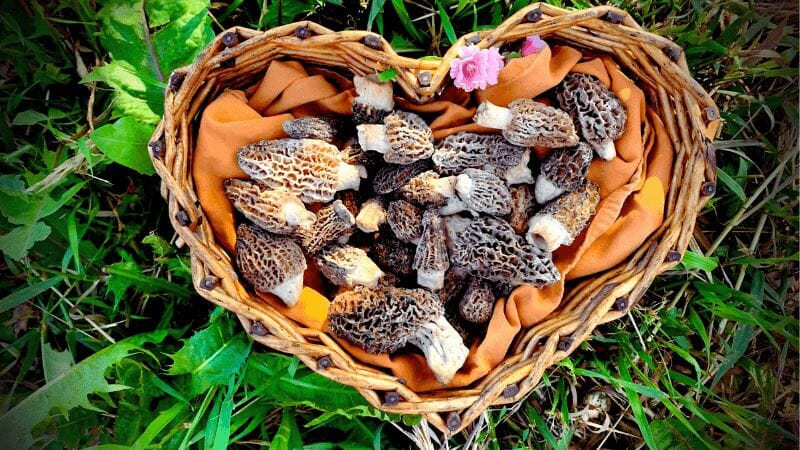A Short Guide to Morel Mushroom Identification
How to Identify Morel Mushrooms in the Wild
Morel mushrooms are one of the most highly sought-after varieties of above-ground wild fungi. The scarcity, seasonality, and flavor of this wild edible all furnish their desirability, of course, but there is another factor that contributes to their allure—the fact that they have proven to be incredibly difficult to cultivate, which has driven their price up, making foraging well worth the effort.
When it comes to hunting wild mushroom species, however, extreme care must be taken to ensure what you have found is indeed edible and not a poisonous imposter.
In this article, we will examine the distinctive traits of morel mushrooms, their ideal climate types, locations, poisonous doppelgängers, and where to find them when they aren’t actually in season.
It should be noted, that when foraging for any type of mushroom, including morels, one should never solely rely on information they have read online. Definitely do your research and use that research as a guide, but we recommend asking someone who knows morels well to take you out for your first time. Or, if that proves difficult (morellers tend to be very secretive), after harvesting your mushrooms, take them to an expert to ensure you have properly identified an edible species prior to consumption.
The Secret Life of Morels Revealed
What do morels look like?
It is very easy to identify a morel if you know what to look for. Though, there are several different types, which might make you second-guess yourself. Common colors range from off-white to almost black, with yellow, brown, golden, and gray being the primary harvests. Mature morel mushrooms can be as small as a your thumbnail or bigger than your head! All have leathery caps with crevices and grooves that somewhat resemble that of a honeycomb. The caps are directly connected to the top of the stem, with no portion of the cap hanging loosely. The stem is typically white to tan in color (though this might be hard to distinguish if you have found your morels in a burn area) and much smoother, without the honeycomb-eske indentations (though occasionally, they will contain subtle grooves). Another distinctive trait of morels, and one that clearly sets it apart from toxic morel imposters is that it is hollow all the way through. If you find yourself wondering whether or not you have found a true morchella, simply cut it in half lengthwise. If it is completely hollow, you likely have the real thing.
How to tell the difference between a fake morel and a true morel
As mentioned previously, a true morel mushroom will be hollow. Fake morels, on the other hand, are not. Most are very fibrous within the mushroom, and the bottom of the cap is not attached directly to the top of the stem. Instead, the cap grows out of and down from the top of the stem, hanging over a large portion of it. When in doubt, always cut them open to determine whether or not they are hollow and at which point on the stem the cap is attached. The first thing you will likely notice about a false morel, though, is the outward appearance. They are not uniform, like the true morel and typically have a reddish, chestnut, or purple tint to them. The distinctive grooves and ridges of a true morel, are also not present on the cap of a false version; this may not be obvious from a distance, but you will clearly notice markings that are more wavey, irregular, and/or bulbous in form, often resembling a mishapen brain.
Where can you find morel mushrooms?
Morels are most frequently found in Europe and the North America, though they are also prevalent in other areas of the world. They prefer soil temperatures to be around 45-50 degrees, with daytime air temperatures warming up to around 60-80 degrees.You can often get a head start on the morelling season by searching southward facing slopes. Once the season has transitioned to hot weather, you won’t likely find many morels (but, you could always climb to higher elevations where the soil and air temperatures will be cooler). Some of the areas morchellas prefer are along river bottoms and creek beds, especially where there has been a recent disturbance, such as a flood; near cottonwoods, ash, elm, oak, and aspens—by and large near dead or dying trees, as the trees and the mushrooms have a symbiotic relationship; moderate-heat burn areas; and old growth pine forests with high elevation. When hunting for morels, look for areas with good amounts of soil moisture where the sun breaks through the trees.
Can you find morel mushrooms when they aren’t in season?
Morelling is such a rewarding pastime—what’s not to love, you are able to get out in nature and, if you are lucky, bring home a rare and delicious treasure! Sadly, the morel season doesn’t last very long and they have proven incredibly difficult to cultivate, due to their mysterious growth preferences. That doesn’t mean you can’t enjoy them in the off season. Morels are one of the few mushrooms that dry incredibly well, maintaining the same textural and flavor properties once reconstituted. So, if you come across an enormous morel bounty and aren’t able to prepare all of them fresh, don’t be afraid to dry them for later use. Or, if that’s not the case and you didn’t have a successful morel season, you can always find high quality dehydrated morel mushrooms online.







Slofoodgroup
Author